Physical Address
304 North Cardinal St.
Dorchester Center, MA 02124
Ephelides (freckles) are extremely common lesions that present as clusters of small (approximately 2.0 mm in diameter), uniformly pigmented macules ( Fig. 25.1 ). They are directly related to exposure to sunlight and are much more conspicuous in summer than in winter. Sites of predilection therefore include the nose, cheeks, shoulders, and dorsal aspects of the hands and arms. Although virtually everyone shows some degree of freckling, ephelides are particularly common and numerous in individuals with red hair and blue eyes, where there is probably an autosomal mode of inheritance. Ephelides present in childhood, increasing in frequency in adults and typically regressing in the elderly. There is a predilection for females. High levels of freckling may indicate a raised susceptibility to the later development of melanoma. Similarly, increasing numbers of freckles correlate with a higher frequency of acquired melanocytic nevi. Otherwise, although a cosmetic nuisance, they are of no clinical importance. A recent study demonstrated two independent risk factors associated with history of freckle formation; frequent and constant sunburns and the presence of melanocortin-1 receptor gene polymorphism with major variants being associated with more freckling.
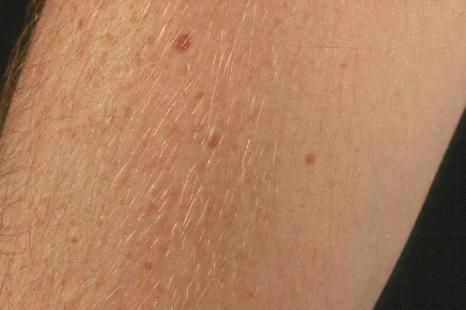
Ephelides are characterized by excessive keratinocyte pigmentation associated with normal or even diminished numbers of melanocytes ( Fig. 25.2 ). The epidermal architecture is normal. Solar elastosis is not a feature of ephelides.
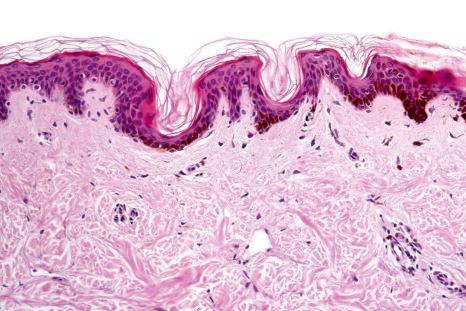
Ultrastructurally, the melanocytes contain enlarged spherical granular melanosomes in contrast to the striated ellipsoid forms seen in normal white skin.
Lentigo simplex is a very common melanocytic lesion. Lesions – which are small (1–5 mm), uniformly pigmented, brown to black, sharply circumscribed macules – may be found anywhere on the integument, the conjunctivae, and mucocutaneous orifices ( Fig. 25.3 ). They often develop in childhood (juvenile lentigo) and become more conspicuous during pregnancy. Rarely, numerous lentigines may develop following an infection or an exanthem, and exceptionally they are generalized (generalized lentigines, lentigines profusa). Segmental lentigines have also been documented. Development of simple lentigines limited to areas treated with tacrolimus has been reported in children with atopic dermatitis. Simple lentigines have also been described in association with type I hereditary punctate palmoplantar keratoderma. Hyperpigmentation and increased numbers of lentigines are features of Addison disease. Simple lentigines have no malignant potential and, in contrast to ephelides, have no connection with sunlight.
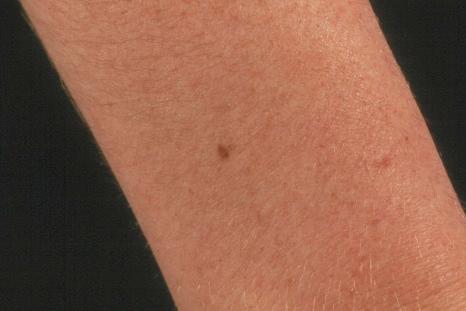
Lentigines assume a particular importance when their presence is associated with a variety of inherited systemic conditions, including Peutz-Jeghers, LEOPARD (multiple lentigines), and Carney syndromes, centrofacial lentiginosis, and Laugier-Hunziker syndrome (idiopathic lenticular mucocutaneous pigmentation). The last is characterized by oral melanotic macules and longitudinal pigmentation of the nails ( Figs 25.4 and 25.5 ). An association between somatic mutation in keratin 10 (KRT10) gene and development of numerous simple lentigos, linear epidermolytic nevus, and epidermolytic nevus comedonicus has also been reported.
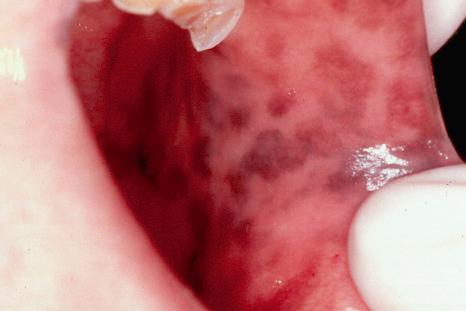
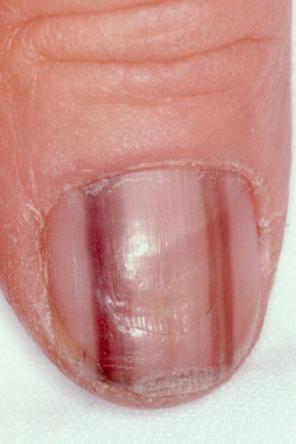
The histologic features are those of slight to moderate elongation of the epidermal ridges associated with an increased number of basally located melanocytes ( Figs 25.6 and 25.7 ). Generally, no atypia of melanocytes is seen. There is no junctional activity and pigmentation is increased, both within the epidermis and within melanophages in the papillary dermis. Rarely, giant melanosomes (macromelanosomes) may be identified ( Fig. 25.8 ). A superficial dermal lymphohistiocytic infiltrate is often present. Not uncommonly, lentigo and junctional nevus may coexist – lentiginous junctional nevus ( Fig. 25.9 ).
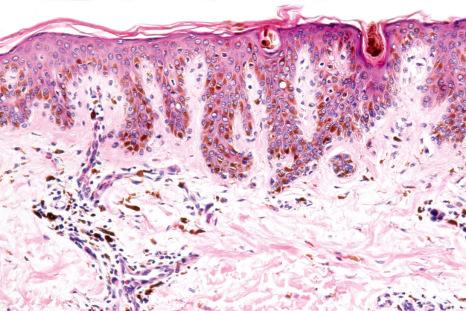
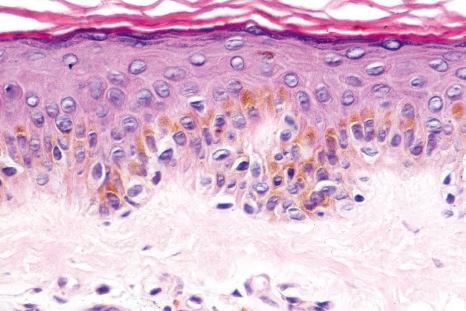
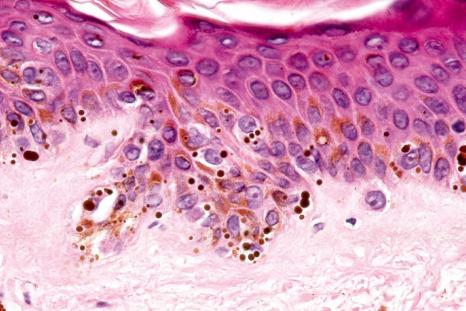
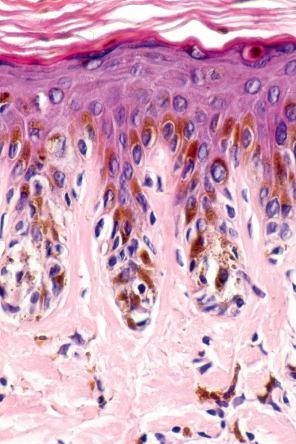
Interestingly, a recent study failed to demonstrate the presence of BRAF V600E mutations in simple lentigo. However, BRAF V600E mutations have been demonstrated in 17% of lentiginous/junctional nevi, in 55% of compound nevi, and in 78% of intradermal nevi.
This disorder, also known as oral melanotic macule and mucosal melanosis, is discussed under pathology of the oral cavity.
This disorder, also known as idiopathic lenticular mucocutaneous pigmentation, is discussed under disorders of pigmentation.
This disorder, also known as melanoacanthosis, is discussed under pathology of the oral cavity.
This disorder is discussed under tumors of the surface epithelium.
This disorder is discussed under disorders of pigmentation.
This disorder, also known as penile lentigo, penile lentiginosis, atypical penile lentigo, vulval lentigo, penile melanosis, and vulval melanosis, is discussed under pathology of the external genitalia.
Acral lentigines are small, 1–5 mm diameter, circumscribed pigmented macules that present on the palms and soles. They are seen more often in blacks than in whites. Eruptive acral lentigines have been reported in patients with AIDS, and also in patients with diffuse large cell lymphoma, breast cancer, gastric adenocarcinoma, and advanced stage melanoma. Acral lentigines are devoid of sinister potential.
Acral lentigines are histologically identical to lentigo simplex ( Fig. 25.10 ).
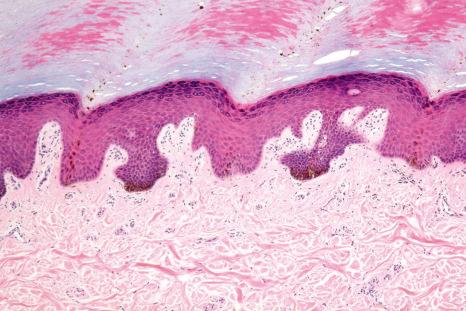
This disorder is discussed under disorders of pigmentation.
Lentigines are a feature of Carney complex ( Fig. 25.11 ). This topic is discussed under disorders of pigmentation, epithelioid blue nevus, and superficial angiomyxoma.
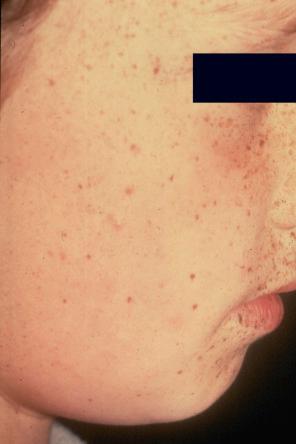
Centrofacial lentiginosis is a rare autosomal dominant condition in which patients develop a characteristic zone of pigmented macules, particularly about the central region of the face ( Fig. 25.12 ). They may also have a variety of skeletal abnormalities including high arched palate, dental malpositions, cervical or cervicothoracic kyphosis, funnel chest, winged scapulae, spina bifida, hammer toes, bilateral pes cavus, and sacral dehiscence. They can also suffer from neuropsychiatric disturbances including mental retardation, behavioral disturbances, and epilepsy. Endocrine dysfunction, including goiter, hypothyroidism, and calcium metabolism abnormalities, has occasionally been documented. An association of centrofacial lentiginosis and giant nevus spilus developing on the left side of the upper back in a dermatomal distribution has been reported in a child.
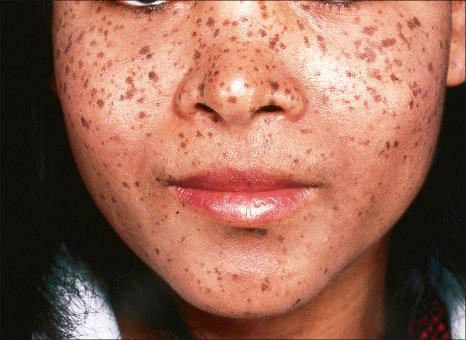
The histologic features of the pigmented macules have not been described.
Long-term psoralen photochemotherapy (PUVA) may be complicated by a variety of cutaneous pigmentary changes including variable hyper- and hypopigmentation, vitiligo-like features, and multiple lentigines. PUVA lentigines are dose-dependent, irregular, small, brown-black macules that are particularly seen on the shoulders, upper back, and limbs ( Fig. 25.13 ). They are commonly numerous. Males are more often affected than females, and skin types I and II are particularly at risk. Similar lesions have occasionally been described in patients, including one with systemic lupus erythematosus, following the use of sunbeds for artificial tanning. Lesions tend to regress after therapy is discontinued. Development of PUVA lentigines has been reported at the sites of mycosis fungoides lesions, as well as in normal and vitiliginous skin. Furthermore, narrow band ultraviolet (UV) B used in patients with early-stage mycosis fungoides induce development of lentigines in both involved and non-involved skin much earlier and at lower cumulative dose than those developing after PUVA treatment. However, lentigines develop less frequently than those presenting after PUVA treatment.
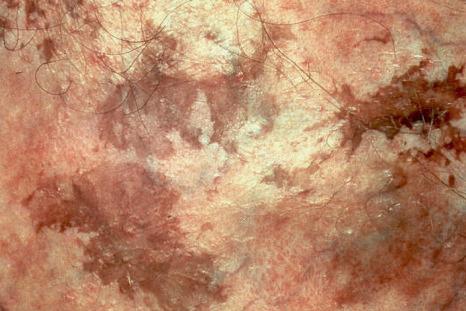
The presence of T1799 BRAF mutations has been demonstrated in 33% of PUVA lentigines.
Histologically, PUVA lentigines show a variety of features. In some, there is increase in basal cell pigmentation with no increase in melanocyte numbers, reminiscent of an ephelis, whereas others resemble lentigines with pronounced rete ridge elongation and increased numbers of melanocytes ( Fig. 25.14 ). Melanocytic nuclear atypia including enlargement, pleomorphism, and hyperchromasia, multinucleation, and giant melanosomes has been described. There does not appear to be any link between PUVA lentigines and development of melanoma.
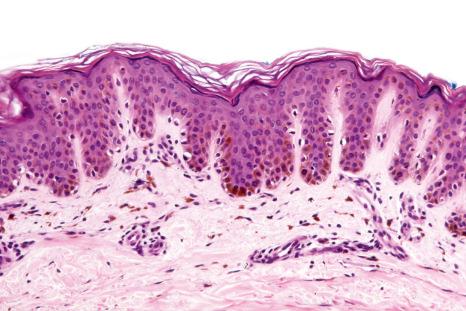
Epidermal abnormalities, including dyskeratosis and actinic keratosis-like features, may also sometimes be observed.
Ink spot lentigo (reticulated black solar lentigo, reticular lentigo, acquired reticulated lentigo, reticulated melanotic macule) is a rare variant of lentigo; it is particularly important because clinically it may be confused with melanoma. It affects fair-skinned individuals with red to blond hair and blue eyes (skin types I and II) and presents on a background of solar-damaged skin as a usually solitary, irregular, reticulated black macule with a wiry or beaded appearance (reminiscent of an ink spot) ( Fig. 25.15 ). Although the features may be clinically worrying, the lesion is completely benign. Ink spot lentigo can exceptionally develop in the background of a nevus spilus.
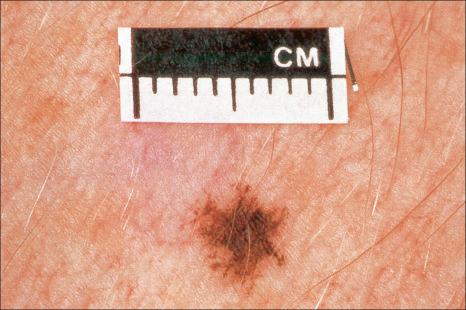
Ink spot lentigo shows lentiginous hyperplasia with very marked basal cell hyperpigmentation, rete-tip accentuation, and characteristic achromic skip areas ( Fig. 25.16 ). Melanocytes may be normal or slightly increased in number, but there is no cytological atypia or junctional activity. Pigmentary incontinence is usually evident, and a perivascular chronic inflammatory cell infiltrate is commonly present.
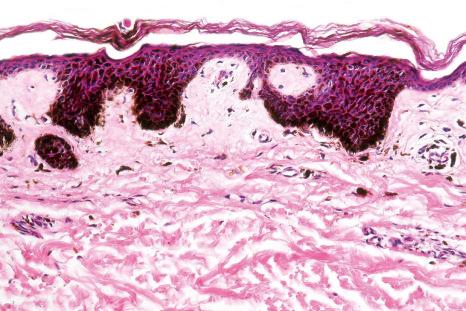
Becker nevus (pigmented hairy epidermal nevus, Becker melanosis, melanosis neviformis Becker) is an androgen-dependent organoid lesion that becomes more prominent after puberty. It is uncommon and probably shows an equal sex distribution, although lesions in females are said to be more difficult to appreciate than in males. While all races may be affected, there appears to be a predilection for non-whites. It usually presents in the second decade, initially as a light to dark brown enlarging macular lesion, which subsequently shows hypertrichosis ( Fig. 25.17 ). Although most frequently the chest, shoulder, or upper arm are involved, examples have occurred everywhere on the skin surface. Lesions on the scalp or face can be associated with asymmetrical growth of scalp hair or beard. Sometimes they are multiple, and familial examples have been recorded. Rarely, Becker nevus may be congenital. Linear distribution of congenital Becker nevus following Blaschko lines, giant bilateral Becker nevus over the back, chest and upper arms, as well as symmetrical bilateral Becker nevus on the anterior chest and back have also been reported. Involvement of oral mucosa in a case with segmental distribution on the face has also been described. Of particular importance is the occasional association of Becker nevus with developmental anomalies, including cutaneous, muscular, and skeletal anomalies – the so-called pigmented hairy epidermal nevus syndrome (e.g., breast and limb hypoplasia, pectus excavatum, spina bifida, scoliosis, and hypoplasia of subcutaneous fatty tissue, to mention just the most common conditions). A case in which a scalp lesion occurred with underlying loss of cranium has been documented.
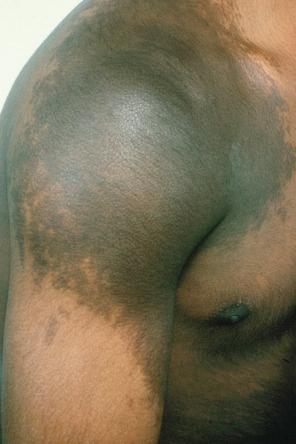
Becker nevus is thought to be the consequence of an early postzygotic mutational event representing a genetic mosaicism.
The features are subtle, comprising slight hyperkeratosis, variable acanthosis, and elongation of the epidermal ridges, accompanied by increased pigmentation in the basal region ( Figs 25.18–25.20 ). Additional changes can include flattening of the epidermis, keratotic plugging, and fusion of two or three neighboring elongated rete ridges. In contrast to uninvolved epidermis, the epidermis of Becker nevus shows increased expression of androgen receptors. Melanocytes often appear increased in number, but there is no evidence of proliferative activity. The superficial dermis may contain melanophages, and a mild perivascular chronic inflammatory cell infiltrate is sometimes present.
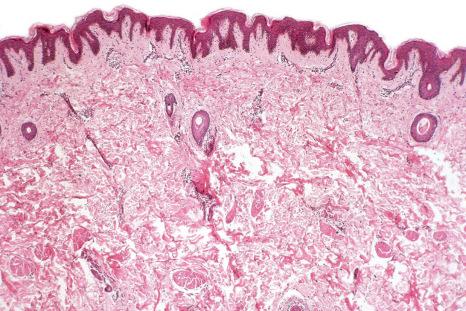
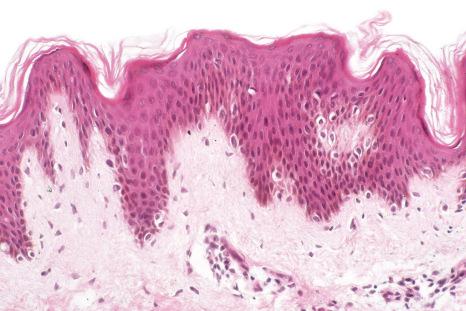
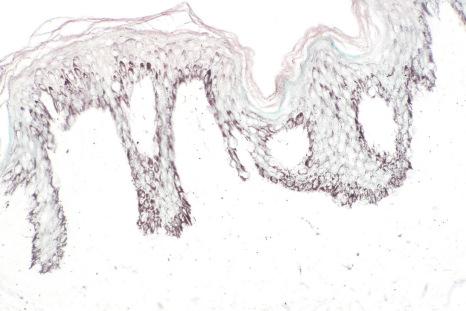
In occasional lesions, the reticular dermis contains large numbers of hamartomatous, irregular, enlarged smooth muscle fibers ( Fig. 25.21 ). Associated dermal fibrosis, sebaceous hyperplasia, neves sebaceous, localized acneiform lesions, solitary plexiform neurofibroma, neurofibromatosis type I, basal cell carcinoma, compound melanocytic nevus, pigmented epithelioid melanocytoma, nevus anemicus, lichen planus, pityriasis versicolor, a psoriasiform dermatitis suggestive of an inflammatory linear verrucous epidermal nevus, and hyperkeratosis with focal diminution of granular cell layer (e.g., ichthyotic changes) have also been documented.
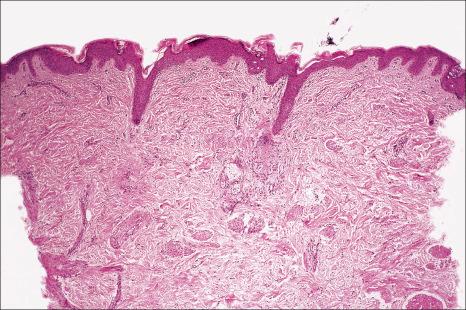
Ultrastructural studies have revealed an increased number and size of compound melanosomes within basal keratinocytes. An increase in the number of melanosomes per complex may also be evident.
Pseudomelanocytic nests are aggregates of nonmelanocytic cells, or cell fragments within the epidermis mimicking a melanocytic proliferation on histologic examination. These nests usually develop in the setting of lichenoid tissue reactions, for example, fixed drug eruptions, phototoxic reactions, lichen planus pigmentosus, lupus erythematosus, or pigmented lichenoid keratosis.
Patients are usually adults in their sixth decade of life with equal gender distribution. The lesions are either solitary or multiple and of recent onset. Interestingly, pseudomelanocytic nests have also been reported in the oral mucosa. Clinicopathological correlation is essential for correct recognition of these lesions.
Pseudomelanocytic nests represent irregularly sized and usually dyscohesive collections of keratinocytes, macrophages, and lymphocytes along the dermal–epidermal junction. In addition, isolated melanocytes can also be present within the nests, but they generally do not exceed two cells. Nonmelanocytic cells within the nests frequently contain cytoplasmic melanin pigment. The epidermis can display irregular acanthosis with effacement of the rete ridges, but it is more frequently atrophic. A variably dense lichenoid inflammatory cell infiltrate including melanophages is also seen. Solar elastosis is commonly seen on sun-exposed sites.
By immunohistochemistry, nonmelanocytic cells within the nests can express Melan-A/MART-1 positivity, but are usually S100, tyrosinase, and HMB-45 negative. It is believed that Melan-A/MART-1 positivity is the result of non-specific staining of melanosomes within the cytoplasm of cells other than melanocytes, thus representing a potential diagnostic pitfall that may lead to a misdiagnosis of a melanocytic proliferation, in particular, melanoma in situ.
Pseudomelanocytic nests should be distinguished from melanoma in situ. The latter is typically associated with lentiginous, nested, and pagetoid proliferation of atypical melanocytes. A combination of melanocytic markers, including S100, SOX-10, microphthalmia transcription factor, and tyrosinase, should aid in distinction in dubious cases. Clinicopathological correlation is essential.
Melanocytic nevus (banal nevus) is a benign tumor that usually presents in childhood and adolescence. The sex distribution is equal. An average white individual can expect to develop 15–40 such lesions during life, reaching the maximum number in the third decade before regression to virtual disappearance by the eighth and ninth decades.
In addition to those derived from hair-bearing skin, melanocytic nevi may develop on glabrous skin, beneath fingernails and toenails, within the conjunctivae and uveal tract, and mucosae ( Fig. 25.22 ). They have an ordered and histologically defined natural history, which may, to some extent, be predicted from their clinical appearance. Their existence commences as a focus of melanocytic proliferation (junctional activity) within the lower reaches of the epithelium, the so-called junctional nevus. This progresses to the presence of melanocytes within both the epidermis and the dermis, which is the compound nevus. Further development results in a completely intradermal lesion called the dermal nevus.
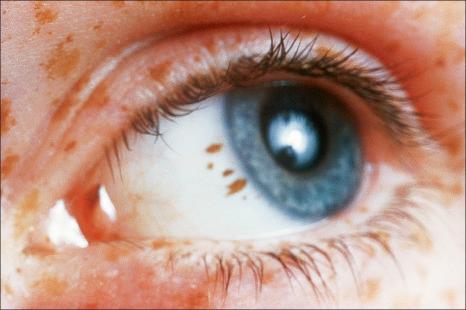
While there is unquestionable malignant transformation on occasions in these lesions, such events are rare; therefore, there is no indication for widespread prophylactic excision of otherwise typical melanocytic nevi ( Figs 25.23 and 25.24 ). It has been estimated that the likelihood of any one nevus evolving into melanoma is roughly 1/100 000. Subsequent mortality is of the order of 1/500 000 original nevi. However, the prevalence of nevi is of major epidemiological importance, increased numbers correlating with a greater risk of subsequent development of melanoma, of superficial spreading and nodular subtypes. Lentigo maligna melanoma does not derive from pre-existent nevi and is not related to their prevalence. In young children and adolescents in whom these lesions are at an early stage of development, increased pigmentation is to be anticipated. However, in adults, evidence of junctional activity is to be viewed with caution; it is those nevi with increasingly marked pigmentation, or appearing de novo in the older age groups, which are often excised for histologic evaluation.
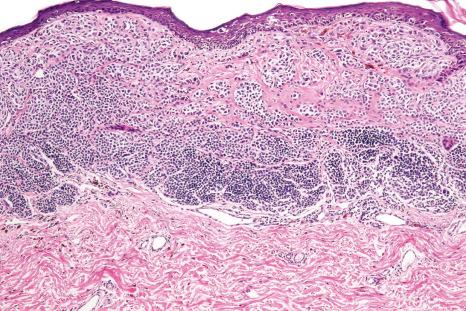
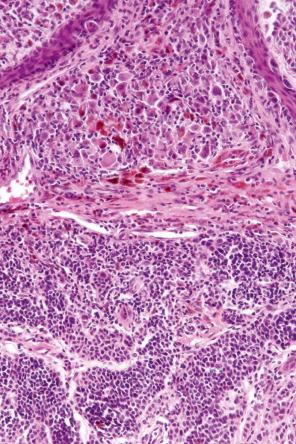
Melanocytic nevi first appear in early childhood and increase in number during the second and third decades. In males, the head, neck, and trunk are particularly affected, whereas in females the upper and lower limbs are more often involved. Distribution of acquired melanocytic nevi in an agminate (grouped) pattern can occasionally be seen. Melanocytic nevi involute during middle age, and most have completely regressed in the elderly. They are more common in individuals with pale skin and light-colored eyes. Melanocytic nevi are much less frequently seen in Asians and Afro-Caribbeans. In these races, the acral sites are particularly affected. Dark brown or black hair correlates with increasing numbers of nevi, whereas red hair appears to protect. Development of melanocytic nevi is related to the extent of sun exposure during the first two decades of life. Intermittent intense sunlight is of greater importance than chronic exposure. In fact, chronic sun exposure correlates with low levels of nevi (i.e., it appears to be protective). Increasing nevus counts are found in individuals who tend to sunburn rather than tan following sun exposure and correlate with the degree of freckling. As these factors are also important in the etiology of melanoma, high levels of freckles and nevi at an early age may be of predictive value.
Melanocytic nevi present a variety of features depending on their stage of evolution. Junctional nevi are usually macular or slightly raised, up to 0.5 cm in diameter and from light to dark brown in color ( Figs 25.25–25.27 ). They are well circumscribed with a regular border and are usually uniformly pigmented, but sometimes the central area is darker. Typically, the skin lines can be clearly discerned on the surface of the lesion.
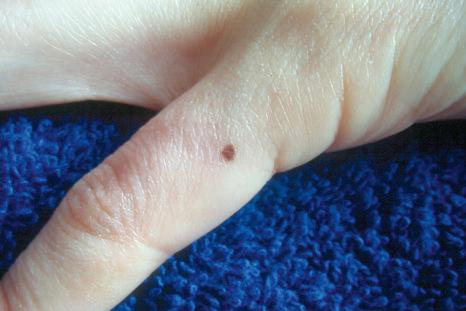
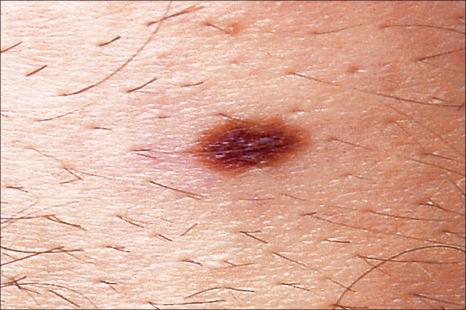
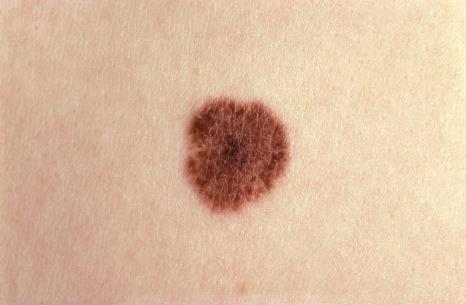
The compound nevus is raised, sometimes dome-shaped or warty, and often still deeply pigmented ( Figs 25.28 and 25.29 ). Occasionally, there are coarse hairs projecting from its surface; plucking these hairs may traumatize the dermal component of the hair follicle, resulting in granulomatous inflammation, which may cause concern to both the patient and clinician as to the possibility of malignant transformation.
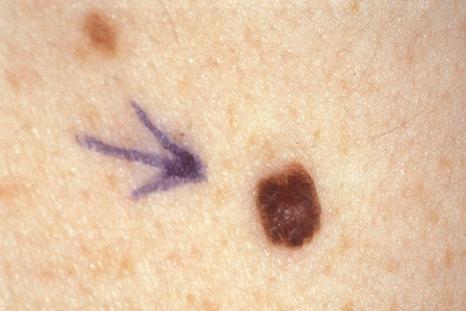
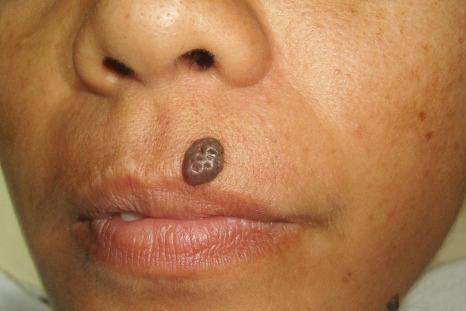
The intradermal nevus is often devoid of pigment and may present as a dome-shaped nodule, a papillomatous lesion, or a pedunculated skin tag ( Figs 25.30 and 25.31 ).
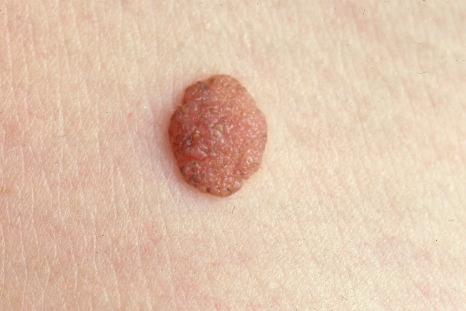
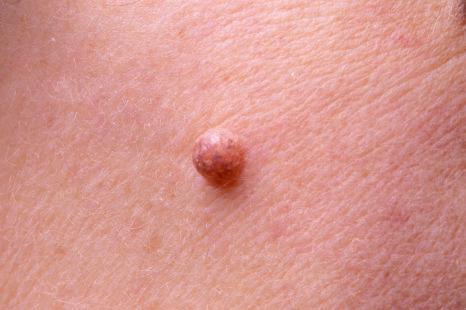
Nevi may become more highly pigmented under the influence of pregnancy or the oral contraceptive pill. There is, however, no evidence that pregnancy in any significant way stimulates their development or alters the biological potential of pre-existent nevi.
There is considerable confusion about the nature of the nevocyte and its distinction from a melanocyte. A nevocyte is merely a melanocyte that has multiplied to form a melanocytic nevus. It has the same electron microscopic appearance as a melanocyte, and identical organelles and enzyme systems; the only significant differences are that the dermal component lacks dendritic processes and with increasing depth melanin synthesis is arrested.
In the earliest stage of development, junctional nests of melanocytes appear in the lower aspect of the epidermis (confined by the basement membrane), usually within the tips or, less often, sides of sometimes broadened and elongated epidermal ridges (lentiginous junctional nevus) ( Figs 25.32 and 25.33 ). The melanocytes may be polygonal and epithelioid, or more rarely spindled with clear to pale staining or lightly eosinophilic cytoplasm, and contain uniform round to oval small nuclei with prominent nucleoli (type A nevus cells) ( Figs 25.34 and 25.35 ). The cytoplasm typically contains sparse, evenly distributed, delicate melanin granules. In benign junctional nevi, growth is towards dermal involvement. Any tendency for melanocytes to spread towards the upper reaches of the epidermis (pagetoid spread) is suggestive of malignant change and should be viewed with caution. However, upward migration of melanocytes on its own is not diagnostic of malignancy as this feature may be seen in variants of nevi-like lesions occurring at some special sites (see below). Melanocytes between epidermal ridges may sometimes appear increased in number. By definition, junctional nevi are solely intraepidermal; however, in heavily pigmented variants, melanin is typically present in macrophages (melanophages) within the papillary dermis (pigmentary incontinence).
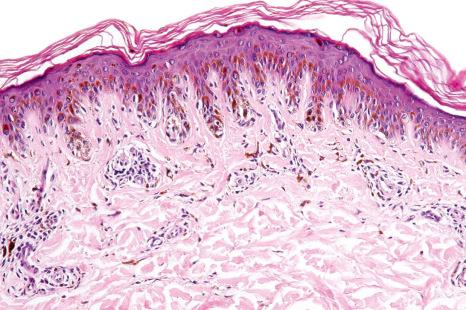
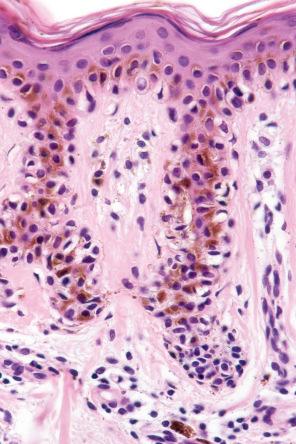
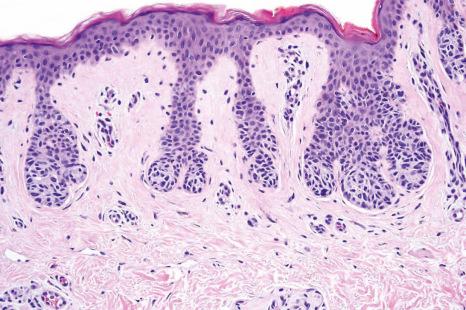
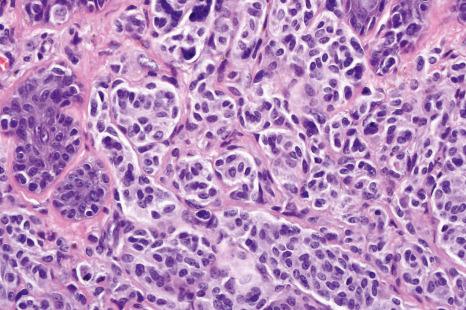
In addition to junctional activity, compound nevi show nests and strands of nevus cells within both the papillary and the superficial reticular dermis ( Figs 25.36–25.39 ). Compound banal nevi are usually fairly well circumscribed and symmetrical. The junctional component does not typically extend beyond the dermal component, i.e., a shoulder is absent in the majority of banal nevi (compare with dysplastic nevus). It should, however, be noted that a shoulder can sometimes be present in a banal compound nevus, i.e., the presence of a shoulder in itself does not make a nevus dysplastic. Compound nevi may sometimes be associated with marked hyperkeratosis, acanthosis with keratinous pseudocyst formation, and papillomatosis (reminiscent of a seborrheic keratosis), accounting for a warty clinical appearance – the so-called papillomatous (verrucous) melanocytic nevus or keratotic melanocytic nevus ( Fig. 25.40 ). These nevi are more often found in females, and the trunk is the commonest site affected. The change may be related to estrogens as the nevus cells express pS2.
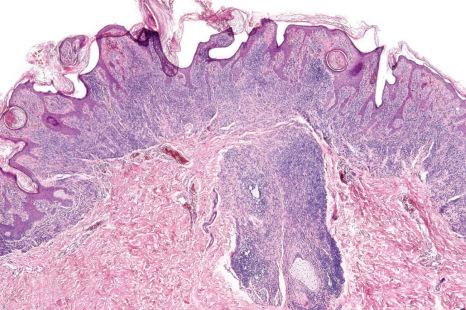
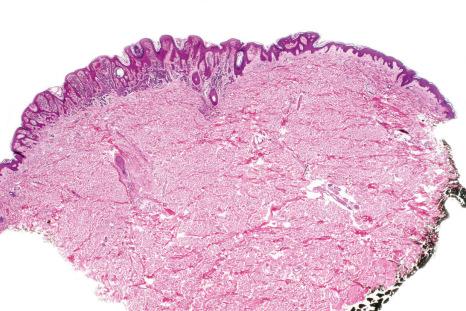
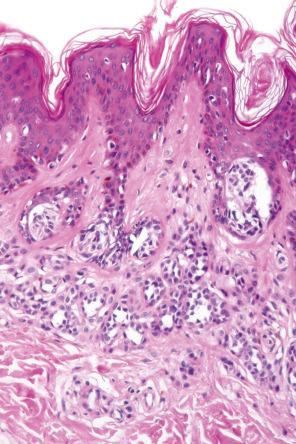
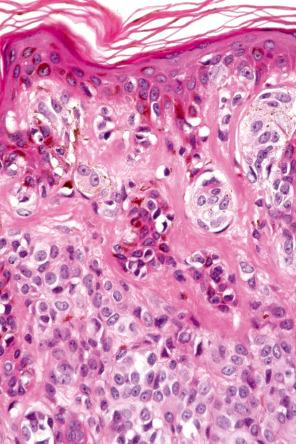
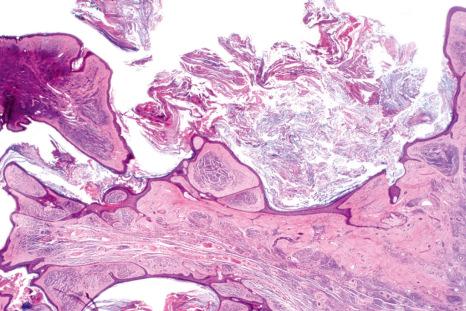
The cells of the more superficial component of the dermal lesion may retain cytological characteristics similar to the junctional nevus. The cells in the deeper aspect are much smaller with less cytoplasm and have dense, more darkly staining nuclei resembling lymphocytes (type B nevus cells) ( Figs 25.41–25.43 ). Mitotic activity can occasionally be seen in the dermal component of an acquired melanocytic nevus (see differential diagnosis ). Mitotic activity may also be increased in melanocytic nevi in pregnancy. An analysis of dermal mitoses in otherwise banal compound melanocytic nevi has demonstrated the mean number of 0.024 dermal mitoses/mm 2 . Mitoses are normal and never atypical, evenly distributed, usually located in the upper half of the dermis, and do not appear in clusters. Although isolated regular mitoses can also be seen in the deep dermal melanocytic component, they are about three times less frequent than mitoses in the upper half of the dermis. Importantly, banal nevi with dermal mitoses are significantly more common in younger age groups (e.g., between 0 and 20 years of age). Therefore, more than an occasional dermal mitosis in older patients should be viewed with caution.
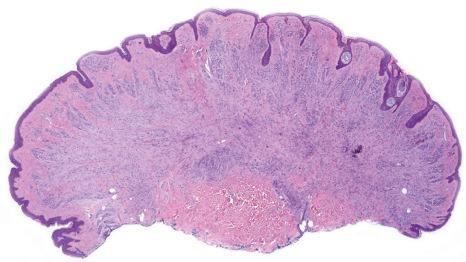
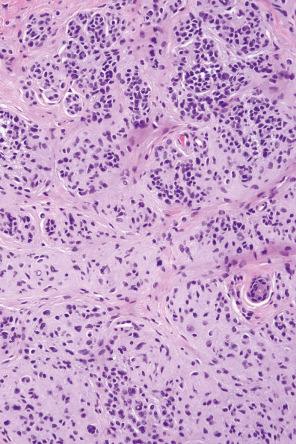
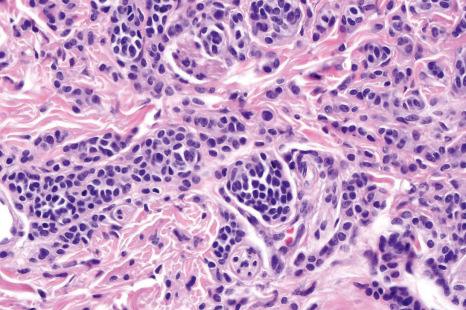
The dermal nevus, the ‘end stage’ of the melanocytic nevus, is typified by progressively less pigmentation with atrophy (so-called nevus maturation) ( Fig. 25.44 ). This is usually accompanied by the accumulation of loose fibrous tissue. Rarely, dense fibrosis may develop, resulting in separation of individual residual melanocytes (desmoplastic nevus) (see below). In some dermal nevi, there may be worrying nuclear pleomorphism and hyperchromatism. The latter, however, appears smudged, and the nuclei are devoid of nucleoli and mitotic activity (ancient nevus, nevus with senescent atypia).
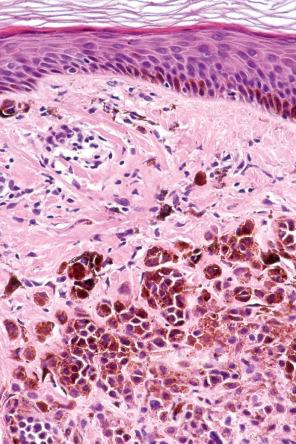
In dermal nevi, the melanocytes often develop spindled cell and Schwann cell-like characteristics (neurotization), such as a fibrillar appearance with pale eosinophilic cytoplasm and wavy nuclei (type C nevus cells) ( Fig. 25.45 ). Cholinesterase positivity may be present, and often Meissner corpuscle-like structures are found ( Figs 25.46 and 25.47 ). The cells are nevertheless still truly melanocytic: ultrastructurally, they contain melanosomes. In addition, they are S100 and dopa positive and do not show Schwann cell morphology, nor do they react with antibodies to myelin basic protein. Occasionally, intradermal nevi take on truly neurofibromatous appearances ( Fig. 25.48 ). Other features of ‘maturation’/senescence in dermal nevi include giant cell formation, mucinous degeneration, xanthomatization, and fat accumulation ( Figs 25.49–25.51 ). More rarely, changes include calcification and bone formation (usually based on a degenerate hair follicle) ( Fig. 25.52 ). Lesions with bone formation are known as osteonevus of Nanta. A not uncommon observation is the presence of pseudovascular spaces imparting an angiomatous-like appearance ( Figs 25.53 and 25.54 ). The cause of this change is unknown, although it is probably artifactual and may relate to the effect of a local anesthetic. Immunohistochemical studies using endothelial cell markers are invariably negative. The cells lining the spaces are of melanocytic derivation and label positively with S100 protein. Amyloid may rarely be identified within a nevus. Exceptionally, a nevus may be accompanied by proliferation of the sweat gland epithelium; coexistence of nevus and desmoplastic trichoepithelioma is occasionally encountered. Melanocytic nevus has also been reported in association with a trichoadenoma.
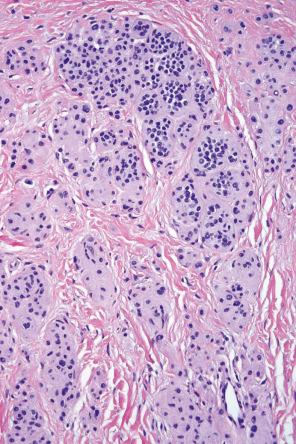
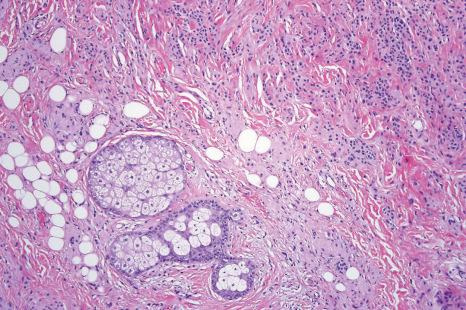
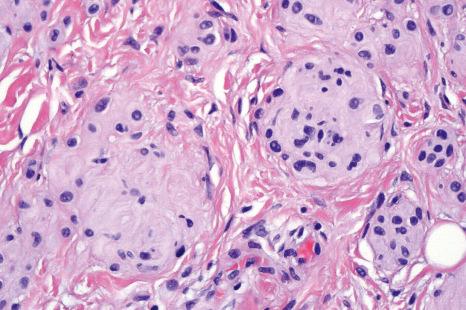
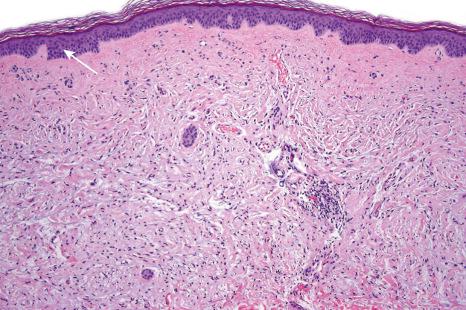
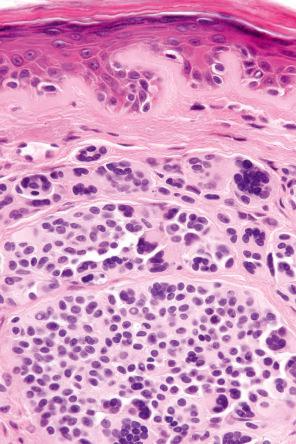
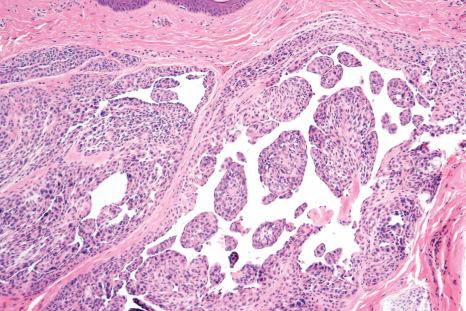
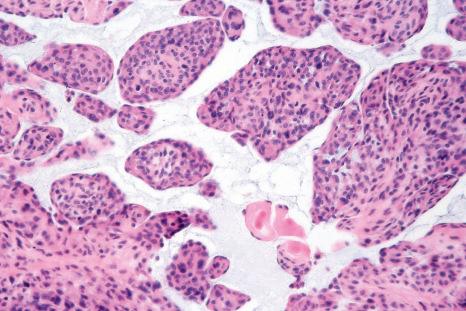
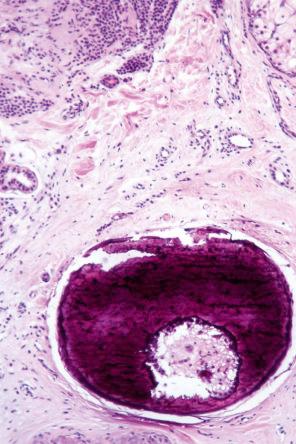
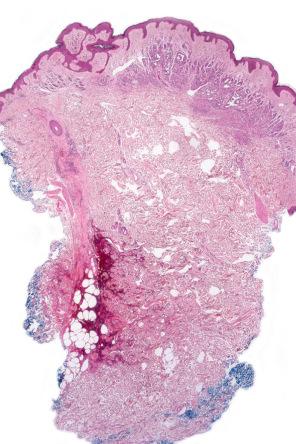
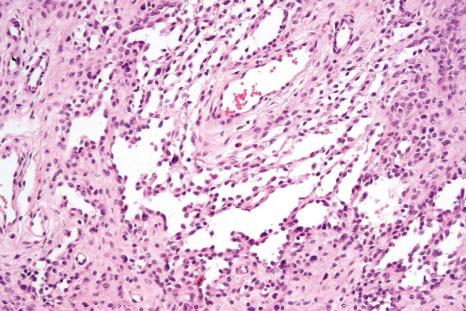
The presence of intravascular melanocytes or evidence of lymphatic involvement is a very disturbing finding and should prompt a thorough search for other features of melanoma. Herniation of a nevus nest into the lumen of a vessel should not be confused with vascular invasion. The distinction can be made by finding a layer of endothelium covering the protruding nevus cells in the benign lesion ( Fig. 25.55 ).
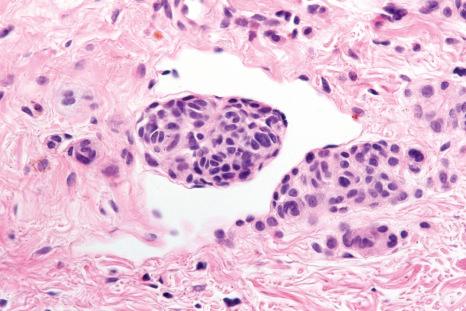
Distinction between a banal nevus and melanoma in the majority of cases is straightforward. Low-power examination of melanoma may reveal obvious intralesional transformation, i.e., the malignant cells stand out as an expansile and often circumscribed nest, nodule, or plaque that is cytologically different from the adjacent nevus cells. Additional distinguishing features include the presence of dense pigmentation, lack of maturation, nuclear pleomorphism, mitotic activity, apoptosis, lymphocytic infiltration, and a deep nested growth pattern, which are commonly evident in melanoma but not in intradermal nevi. Upward, intraepidermal, or pagetoid spread of melanocytes is an additional feature seen in many melanomas. Caution, however, is advised when viewing sections from neonatal and even childhood nevi when nests and occasionally single cells, sometimes showing mild or even severe cytological atypia, may be identified within the upper reaches of the epidermis (see neonatal nevus). Similarly, pagetoid spread may be a feature of acral and genital nevi (see below). Reticulin fibers outline nests of melanoma cells whereas they tend to surround individual nevus cells.
Dermal nevus cells may rarely show mitotic activity ( Fig. 25.56 ). Their presence should therefore be viewed with caution and other features suggestive of malignancy sought. Nevoid melanoma may be cytologically similar at a casual glance. Careful inspection, however, reveals asymmetry and lack of circumscription, multiple dermal mitoses, subtle lack of maturation, and nucleolar prominence (see nevoid melanoma).
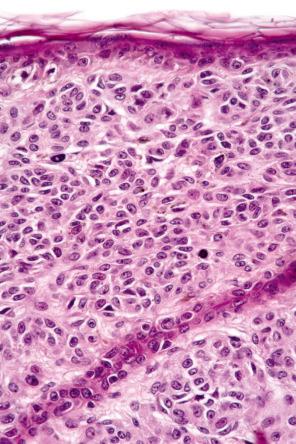
Small cell melanoma cells, although often of a similar size to type B nevus cells, usually have prominent eosinophilic nucleoli, and mitoses are invariably present (see small cell melanoma).
Difficulties are sometimes experienced in differentiating invasive melanoma (particularly the nevoid and small cell variants) from residual benign intradermal nevus cells. The latter is particularly important when assessing tumor thickness or the level of invasion. Immunohistochemistry may be of value in making this distinction. HMB-45 expression is often positive in superficial dermal nevus but is lost with depth ( Figs 25.57 and 25.58 ). In melanoma, in contrast, the tumor cells are often positive throughout the lesion. p53 protein is not expressed in banal dermal nevi. In contrast, it is frequently present in melanoma. In banal nevi, small numbers of Ki-67 and cyclin D1 positive cells may be seen in the more superficial dermal component ( Figs 25.59 and 25.60 ). In melanoma, they are usually much more numerous, and often they are present throughout the thickness of the lesion. The pattern of cyclin D1 staining, however, should not be relied on in the distinction between benign and malignant.
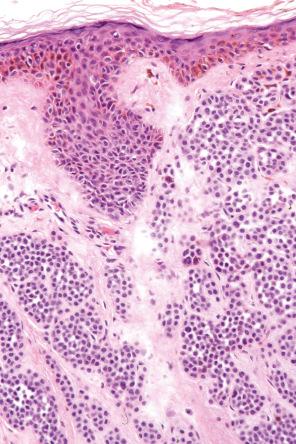
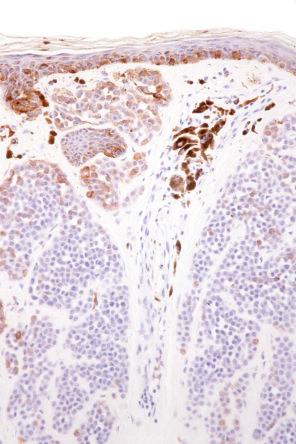
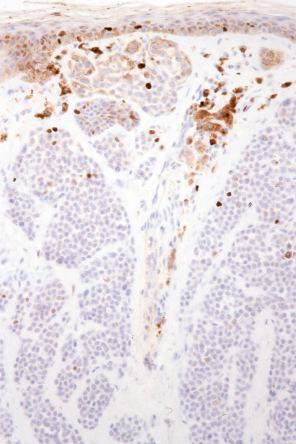
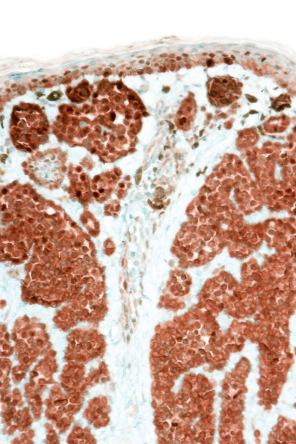
Banal nevi may show some histologic overlap with dysplastic nevi. Thus they are often lentiginous and sometimes show shoulder formation, eosinophilic or lamellar fibrosis around the elongated epidermal ridges. In contrast, architectural disorder (i.e., nests of nevus cells scattered irregularly throughout the epidermis) and bridging are not seen. In addition, cytological atypia is not a feature of banal nevi.
Many so-called clonal nevi (inverted type A nevi) are clinically unremarkable. Those that are recognized are characterized by a recent change, usually in color, in an otherwise typical banal or (less commonly) congenital nevus. Alternatively, they may exhibit darker pigmentation in the background of an otherwise uniformly pigmented nevus.
On dermoscopy, clonal nevi are characterized by a uniform globular/cobblestone pattern typically containing an eccentric fairly uniform blue gray blotch.
This variant of nevus is characterized by the presence of a usually circumscribed nest or collection of nests in the superficial dermis distinct from the background nevoid population ( Figs 25.61–25.64 ). The melanocytes are typically epithelioid, with often abundant, heavily or finely pigmented cytoplasm and irregular nuclei containing small nucleoli. Melanophages are usually numerous in the adjacent dermis, but a lymphocytic response is absent. Mitoses are absent or extremely rare. The nests stand out against the background population of type B nevus cells – hence the designation inverted type A nevus.
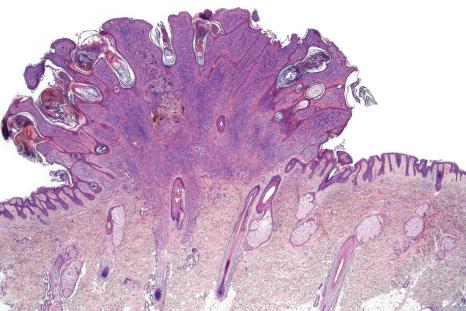
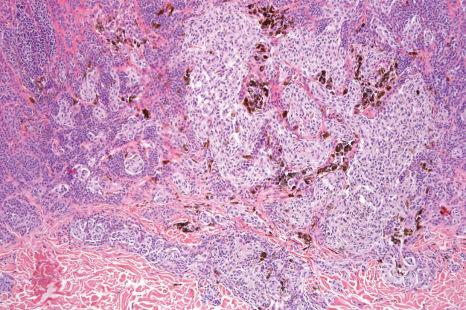
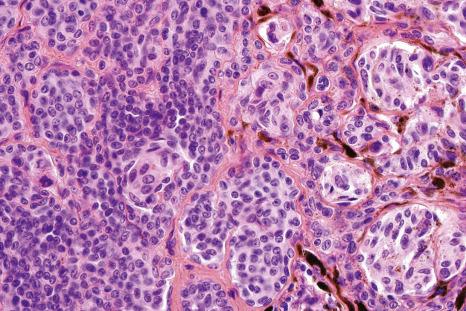
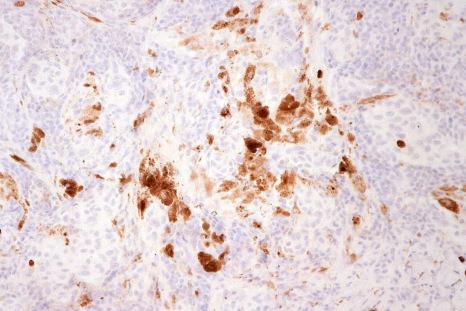
The vast majority of clonal nevi most likely represent combined or deep penetrating nevi. Melanocytic nevi with a focal atypical epithelioid component (clonal nevus) share similar age, anatomic distribution, and cytological features with the deep penetrating nevus, but lack the deep extension of melanocytes.
Eccrine centered nevus (spotted grouped pigmented nevus) is a rare variant of melanocytic nevus, and has been mainly described in the Japanese. Lesions, which are typically congenital, consist of a brown plaque covered by numerous dark brown to black 1–3 mm diameter papules or macules. The trunk and thigh are most commonly affected.
The nevus is characterized by a striking syringocentric distribution. The sweat duct epithelium may be involved but the secretory unit is typically unaffected. The overlying and adjacent epidermis shows features of a lentigo.
Nevi at special sites usually show histologic features identical to nevi seen elsewhere. However, a subset of nevi at special sites displays worrying histologic features that can simulate melanoma. The latter include architectural as well as cytological abnormalities not correlated with an aggressive clinical behavior.
Nevi on the scalp occur most frequently on the occipital region, followed by left parietal region, right parietal region, and frontal region ( Fig. 25.65 ). Their number is related to the number of total body nevi and are most common in the fourth decade of life (mean age, 35 years). Nevi on the scalp show male predominance.
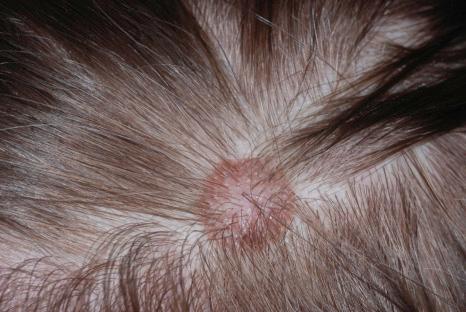
About 10% of nevi on the scalp show disturbing histologic features. Such nevi are usually seen in adolescents and young adults. They have histologic features similar to those found on lesions in the mammary line, genital area, and flexural sites.
Two main morphological patterns of atypical melanocytic nevi can usually be appreciated at this site: a large nested pattern and a pattern mimicking a dysplastic nevus. In general, atypical nevi on the scalp are characterized by asymmetry and poor lateral circumscription ( Figs 25.66–25.70 ). The nested pattern of proliferation consists of large nests of melanocytes located at the tips and sides of rete ridges and randomly scattered along the dermal–epidermal junction. In addition, melanocytic nests show variation in shape, with frequent bizarre forms and discohesion of tumor cells within them. Involvement of skin adnexa can be seen and may be prominent. Focal lentiginous proliferation along the dermal–epidermal junction is frequently present. Melanocytic atypia is usually mild (although occasionally severe cytological atypia is present) and random, and consists of hyperchromatic nuclei and indistinct nucleoli. Upward migration of isolated melanocytes can sometimes be seen in the central part of the lesion. The dysplastic nevus-like pattern is characterized by bridging of the rete ridges, extension of the junctional component past the dermal component, and papillary dermal fibroplasia. The dermal melanocytic component is usually unremarkable, although occasionally superficial mitotic activity can be seen.
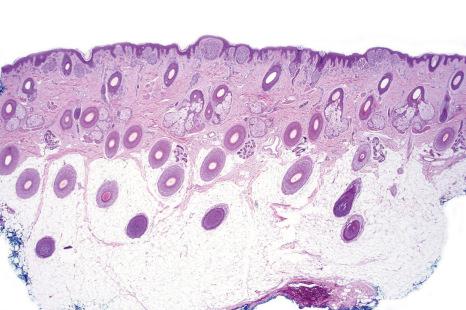
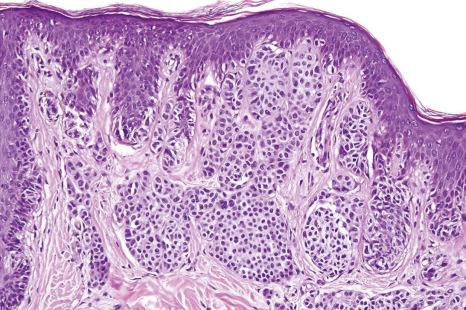
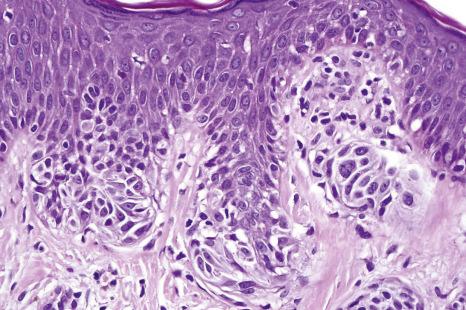
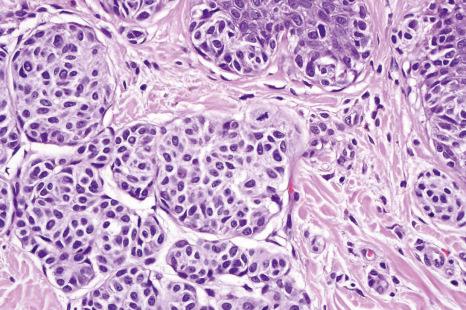
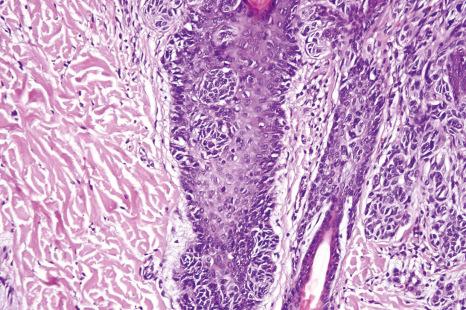
Nevi in and around the skin of the ear demonstrating disturbing histologic features are usually indistinguishable from banal nevi on clinical grounds ( Fig. 25.71 ). Such lesions are most frequently found in the fourth and fifth decades of life (mean age, 45 years). Although a slight male predominance was found in one study, the most recent analysis of melanocytic nevi in the external auditory canal and auricle demonstrated predilection for females.
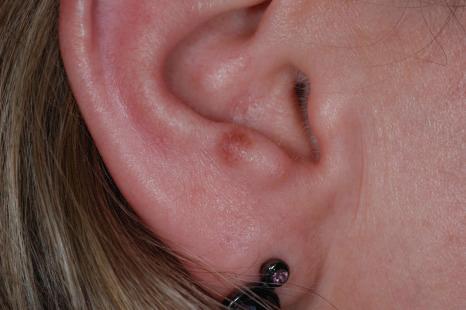
Nevi in and around the ear can demonstrate architectural disarray including poor circumscription, shouldering, bridging, and elongation of rete ridges ( Figs 25.72–25.74 ). Nests of melanocytes show variation in size and shape. Particularly in young patients, junctional melanocytes can display epithelioid morphology with prominent vesicular nuclei, a single basophilic nucleolus, and pink cytoplasm. These lesions often have a Spitz-like appearance. Cytological atypia is sometimes present. Upward migration of single melanocytes into the lower third of the epidermis can be seen.
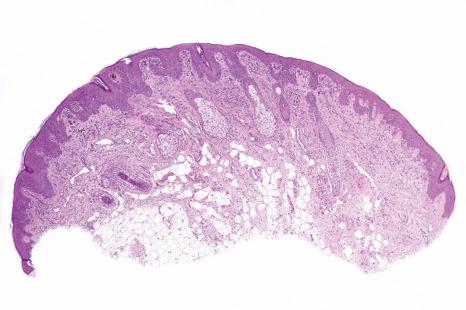
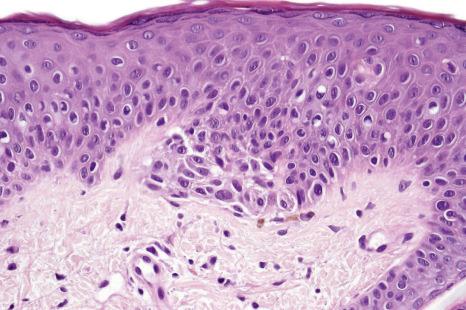
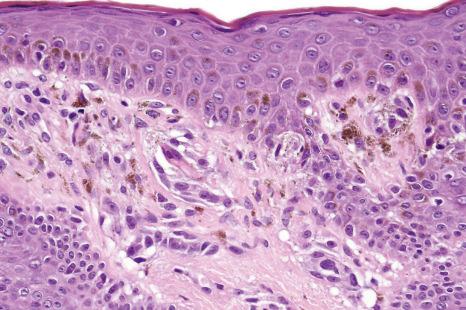
The dermal melanocytic component can also show epithelioid or short spindled cell morphology. Although maturation is generally present and mitotic figures are absent, on occasions there may be atypia of the superficial dermal component particularly in lesions with Spitz-like morphology.
Nevi can occur anywhere on the breast, including in and around the nipple. Unusual histologic features appear to be more common in young adults than in elderly patients.
An analysis of 101 nevi of the breast demonstrated that in comparison to 97 nevi at conventional sites, nevi of the breast more frequently display limited upward migration of melanocytes above the basal layer, presence of random melanocytic cytological atypia, and dermal fibroplasia. Histologic features of nevi of breast are similar in both genders ( Figs 25.75–25.78 ) Nests of melanocytes along the dermal–epidermal junction are variably sized. Confluence of nests which are sometimes dyscohesive can be seen. Melanocytes are enlarged with clear to dusty cytoplasm, and dendritic forms may sometimes be seen. Random cytological atypia is frequent and can also be observed in the melanocytes of the papillary dermis. The deeper dermal component shows maturation and is generally unremarkable with lack of mitosis activity.
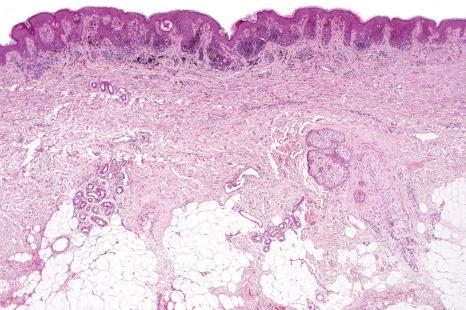
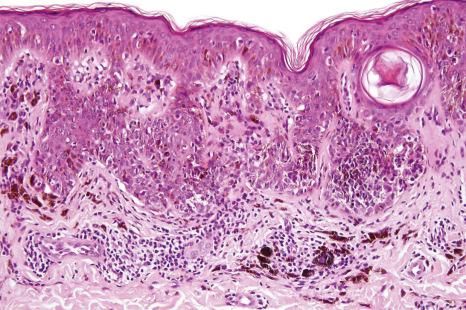
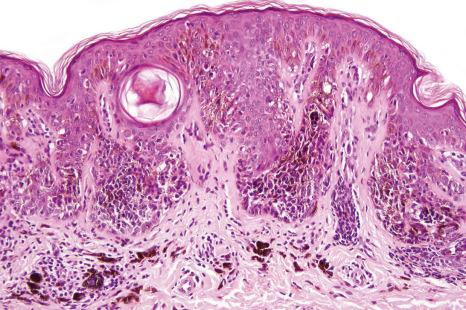
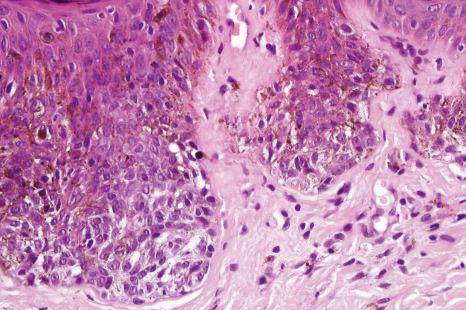
Flexural sites are defined as sites with cutaneous folds, including axilla, mammary folds, popliteal and antecubital fossae, umbilicus, pubis, scrotum, and perianal skin, but also folds on the neck and abdomen. Nevi at flexural sites have predilection for umbilicus and axilla, show equal gender distribution, and have an average size of less than 1 cm. They are well circumscribed and symmetrical. Interestingly, development of agminated flexural melanocytic nevi, involving most commonly the inguinal area and axilla, has been reported in children with a history of Langerhans cell histiocytosis.
The peculiar histologic features of nevi at flexural sites include enlarged junctional nests, variation in the size and shape of nests, confluence of nests, and diminished cohesion of melanocytes within the nests – a so-called nested and dyshesive pattern of melanocytic proliferation. The nests are localized at the tips and sides of the rete ridges. Involvement of skin adnexa is not uncommon. Some degree of nuclear atypia is invariably present. Focal fibrosis at the tips of the rete ridges, often of the lamellar type, can be seen.
A further subset of melanocytic nevi in the umbilicus is characterized by more extensive lentiginous proliferation of melanocytes displaying moderate degree of cytological atypia, focal and limited upward migration, as well as prominent lamellar fibrosis, often extending into the reticular dermis. This peculiar type of lamellar fibrosis frequently contains entrapped melanocytic nests displaying mild cytological atypia, with either horizontal or irregular arrangement of the collagen bundles.
The dermal melanocytic component is unremarkable, maturation is retained, and dermal mitoses are usually absent.
Genital melanocytic nevi are Chapter 12 .
Atypical nevi of the lower leg/ankle have been reported. They are generally small lesions, measuring between 2 and 4 mm (mean diameter, 3 mm), and show female predominance with a ratio of 4 : 1.
Atypical nevi of the lower leg/ankle can be junctional or compound. The lesions may be asymmetrical, lack lateral circumscription, and display single cell proliferation, especially at the lateral aspects. Although focal upward migration into the lower layers of the epidermis may be seen, pagetoid spread into the upper layers is generally not seen. Cytological atypia is usually mild to moderate in degree.
The dermal component, when present, is thin and unremarkable. A mild nonbrisk inflammatory cell infiltrate can be seen. Usually, no dermal fibrosis is identified.
Distinction from dysplastic nevus is made by the absence of the stromal response, typically seen in dysplastic nevi, including lamellar or concentric fibrosis and vascular proliferation. However, it has been suggested that at least some atypical nevi of the lower leg/ankle might actually represent an early dysplastic nevus.
Acral palmar and plantar nevi may be symmetrical, well circumscribed, and identical to banal melanocytic or congenital nevi as seen at any other site, or they may be asymmetrical, poorly circumscribed, and a source of diagnostic difficulty, both clinically and pathologically. Acral nevi are more common in skin-of-color patients and patients with darker Fitzpatrick types than in whites.
The second category (acral nevus), also sometimes known as atypical acral nevus, usually is not distinctive clinically, presenting as a less than 1.0-cm uniformly pigmented dark brown to black macule or papule with irregular and sometimes indistinct margins ( Figs 25.79 and 25.80 ). Similar lesions may also be found on the dorsal surfaces of the hands, feet, and digits, under the nails, and on the knees and elbows. Development of eruptive acral nevi on the sole of the foot has been reported in children following chemotherapy for acute lymphoblastic leukemia.
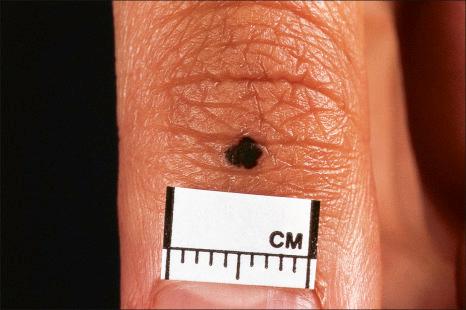
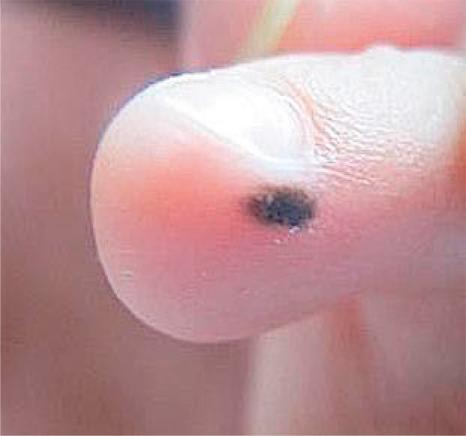
Acral nevi have distinctive features on dermoscopy, which are influenced by their anatomic position. The most common dermoscopic feature represents the parallel furrow pattern and is seen in the majority of acral nevi occurring on non-arch and non weight-bearing parts of the foot. In contrast, acral nevi on the arch of the foot typically display lattice-like pattern, while those on weight-bearing surfaces depict fibrillary or filamentous patterns.
Acral (atypical) nevus is characterized by a circumscribed and usually symmetrical, lentiginous and nested, often continuous, melanocytic proliferation along the dermal–epidermal junction ( Figs 25.81 and 25.82 ). The nests are commonly variable in size and often vertically oriented. A retraction artifact separating them from the adjacent keratinocytes is a characteristic feature. The rete ridges may be elongated and narrowed. The nevus cells have conspicuous pale-staining cytoplasm and hyperchromatic to vesicular nuclei, sometimes showing cytological atypia (usually mild) ( Fig. 25.83 ). Nucleoli may be conspicuous. Mild to moderate pagetoid spread is not uncommonly present, particularly in the center of the nevus. Sometimes pagetoid spread can be very marked and involve almost the entire lesion – such melanocytic proliferation is generally referred to as a melanocytic acral nevus with intraepidermal ascent of cells (MANIAC) ( Fig. 25.84 ). As a result, spotty pigmentation is frequently evident in the stratum corneum. In addition, melanocytes along the dermal–epidermal junction frequently display dendritic morphology. A characteristic feature of acral nevus is transepidermal elimination of nests. Involvement of eccrine ducts by nests of melanocytes is not infrequent, but is usually limited to upper portions of the ducts. Pigmentary incontinence is generally present, and there may be mild fibrosis, rarely accompanied by a sparse lymphocytic infiltrate. Superficial dermal fibrosis is more prominent in lesions from weight-bearing areas such as the soles and should not be interpreted as regression. The dermal component matures with depth and lacks mitotic activity.
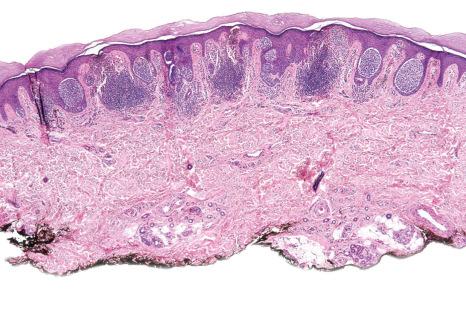
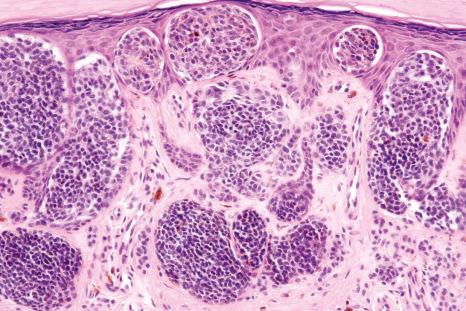
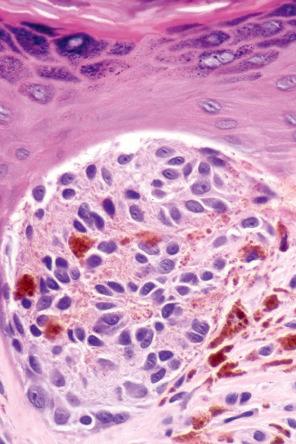
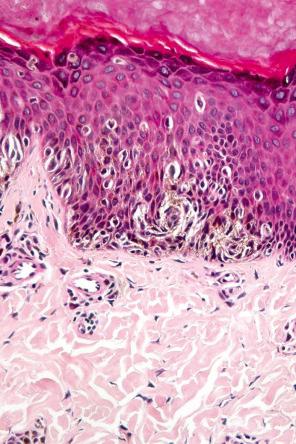
Atypical acral nevus may be distinguished from an acral dysplastic nevus by the absence of a shoulder, dusty pigmentation, and bridging, in addition to lamellar and eosinophilic fibrosis. A host inflammatory response is generally absent in acral nevi. It differs from acral lentiginous melanoma by the absence of irregular epidermal acanthosis, severe cytological atypia, mitotic activity, and by maturation of the dermal component when present. The presence of a dense lymphocytic infiltrate is highly suspicious for melanoma and should prompt careful examination of additional sections for confirmatory features.
Nevus spilus (speckled lentiginous nevus) may be congenital but more often it presents in the first year of life. The sexes are involved equally, and there is a predilection for Caucasians. Up to 2% of the population is affected. It consists of an aggregate of numerous tiny, pigmented macules and papules arising on a lightly tanned or brown macular background ( Figs 25.85 and 25.86 ). Nevus spilus ranges in size from less than 1 cm to more than 10 cm and most commonly arises on the trunk and extremities. Hypertrichosis has rarely been reported in nevus spilus. Lesions are usually solitary. Extensive unilateral (giant) and zosteriform variants have rarely been documented. Nevus spilus has a tendency to grow along Blaschko lines. It may coexist with a plaque blue nevus, bilateral nevus of Ito, or centrofacial lentiginosis and has also been described in association with a nevus sebaceous. Exceptionally, nevus spilus has also been reported in the oral mucosa. Melanoma can, on occasion, develop within a nevus spilus. In such cases, women are particularly affected and the back is most often involved. A speckled lentiginous nevus syndrome has been recognized and consists of a speckled lentiginous nevus in combination with ipsilateral neurological abnormalities such as hyperhidrosis, muscle weakness, and dysesthesia. A medial nerve paresis is a recent addition to the syndrome.
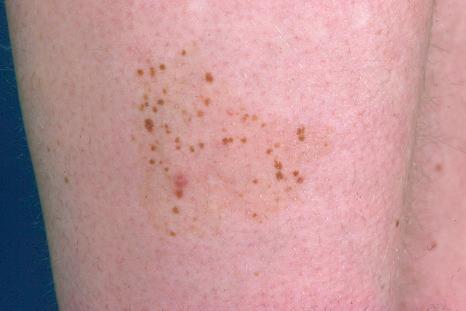
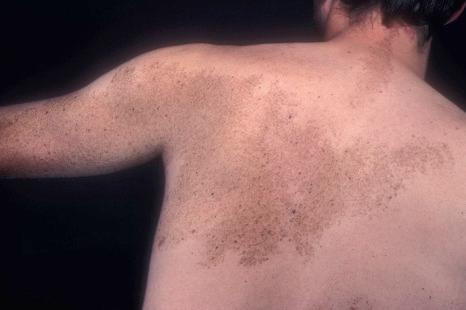
The darkly pigmented speckled areas are characterized by junctional, compound, or dermal nevi. Less often, Spitz nevi and blue nevi also in an agminate pattern may be seen. The intervening background skin may be normal, nevoid, or show lentigo simplex-like features. Cytological atypia may sometimes be encountered. Such lesions with worrying features should be carefully monitored for the subsequent development of melanoma.
Nevus spilus has been demonstrated to harbor activating HRAS point mutations.
The Cockarde (Cockade, rosette-like, target-like) nevus is a very rare variant of banal nevus. It presents as a central pigmented papule separated by an intervening border of normal or flesh-colored skin from a hyperpigmented border ( Fig. 25.87 ). Multiple nevi have been associated with meningomyelocele and vertebral dysplasia.
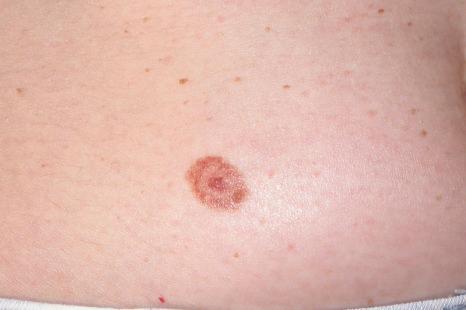
The central pigmented papule in the Cockarde nevus consists of a compound melanocytic lesion, whereas the peripheral aspect is composed of a junctional nevus. The nonpigmented middle zone lacks melanocytes.
Combined nevus is characterized by the occurrence of two or more different populations of melanocytes, i.e., different melanocytic nevus variants within the single lesion. Combined nevi can thus be composed of any combination of common nevi (common acquired nevus, dysplastic nevus, congenital nevus), Spitz nevus, and blue nevus. The most frequent combination represents a common acquired nevus and a deep penetrating nevus. A combined BRAF V600E /BAP loss melanocytic nevus (Wiesner nevus) and ordinary (conventional) melanocytic nevus has gained increasing attention in the recent literature. It has been demonstrated that a subset of a so-called atypical Spitz tumors is characterized genetically by the presence of BAP1 and BRAF V600E mutation occurring in either familial or sporadic setting, the former being associated with development of diverse malignancies, thus representing a cutaneous marker of a cancer syndrome (see corresponding section).
Combined nevi may be a source of concern because of variegate pigmentation and frequent asymmetry. They show an equal sex distribution and have predilection for children and young adults, developing most frequently on the trunk, followed by head and neck, upper extremity, lower extremity, perineum, and buttocks in decreasing order of frequency. Combined nevi have also been documented in mucosal sites, including the conjunctiva.
Different types of melanocytes may be admixed or relatively well separated from each other ( Figs 25.88–25.90 ).
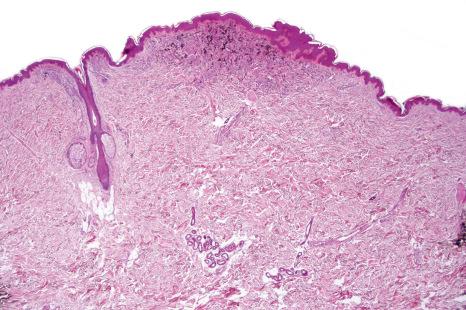
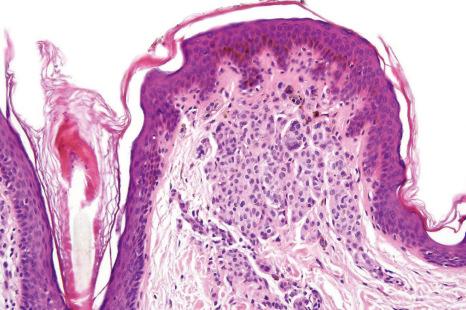
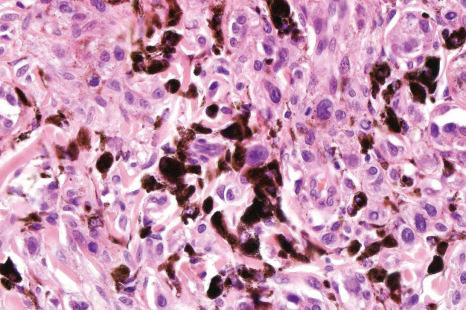
The term malignant combined nevus was used to describe an example of in situ melanoma that complicated a banal and cellular blue nevus.
Combined melanocytic nevus can be distinguished from melanoma by the absence of melanoma in situ in the junctional component, lack of pleomorphism including a prominent nucleolus in tumor cells and expansile growth pattern in the dermal component, and by the absence of or only very occasional normal mitoses in combined nevus.
Recurrent nevus (pseudomelanoma) refers to the development of an atypical melanocytic lesion following inadequate excision of a previous benign melanocytic nevus. It most commonly follows a shave biopsy. Similar changes can also occur after trauma, laser treatment, and local application of topical agents. Recurrent nevus presents as an asymmetrical, irregular, variably pigmented macular lesion, often with stippled black areas restricted to the area of the scar ( Fig. 25.91 ). In contrast, recurrent Spitz and blue nevi are frequently papular or nodular lesions that extend beyond the confines of the scar. Furthermore, recurrent Spitz nevus can exceptionally present with multiple satellite nodules in the area of previous excision. In general, recurrences most commonly develop within 6 months following the initial procedure, show female predominance, and most frequently occur on the back.
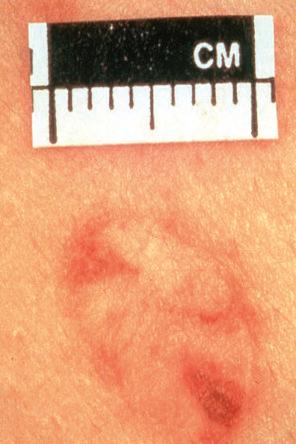
On dermoscopy, helpful clues for recurrent/persistent melanocytic nevus include symmetry of the proliferation, the presence of radial lines, and centrifugal growth. In contrast, the single most important parameter suggestive of melanoma was found to be pigmentation beyond the confines of the scar.
Remnants of the previously excised nevus are often evident in the superficial dermis accompanied by dermal scarring; a superficial perivascular chronic inflammatory cell infiltrate is commonly present ( Fig. 25.92 ). Melanophages are usually conspicuous.
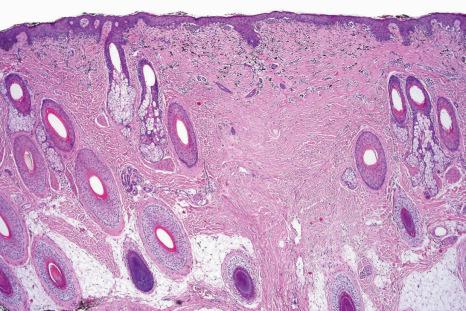
The significant histologic features, however, are present in the epidermis. The junctional component is sharply delineated and characteristically does not extend beyond the area of scarring. Recurrent nevus consists of atypical melanocytes, both singly and in clusters, usually in the lower epidermis and sometimes showing mild or moderate nuclear pleomorphism and hyperchromatism ( Fig. 25.93 ). An epithelioid morphology of melanocytes usually predominates. Slight pagetoid spread is sometimes evident. Mitotic figures are not usually present, and apoptosis is not a feature. The rete ridge pattern overlying the scar is frequently effaced. On occasions, however, epidermal hyperplasia in a retiform pattern confined to the area of the scar can be seen. Cytological atypia is sometimes evident in the superficial dermal component associated with scar (when present) ( Fig. 25.94 ). In some cases, a residual ordinary component of the nevus is seen in the area underlying the scar. Dermal mitoses are generally absent although, exceptionally, careful scrutiny may reveal an occasional normal mitosis.
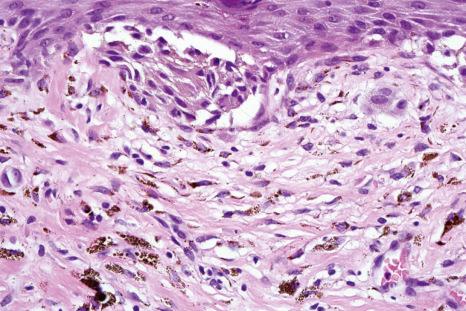
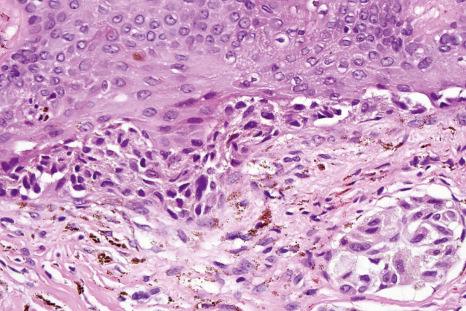
In the absence of clinical information, melanoma may be suspected initially. Histologic points of distinction include the characteristic circumscription, the sharp restriction of the junctional component to the area immediately overlying the scar, the lack of mitotic activity and apoptosis, and the presence of dense reactive scarring.
Clinicopathological correlation is essential. It should also be borne in mind that residual dysplastic nevi may be associated with a recurrent nevus phenomenon, and incompletely excised melanoma in situ may mimic a recurrent nevus. Review of previous pathological material is essential in difficult cases.
The pseudomelanoma phenomenon has also been reported in a subset of melanocytic nevi, the so-called sclerosing nevi. These are characterized histologically by a central area of scarring, not related to previous procedure or trauma, accompanied by remnants of a nevus at the periphery of the scar. Similar to the pseudomelanoma phenomenon in recurrent nevi, the epidermal component in sclerosing nevus consists of irregularly sized and confluent nests of melanocytes with occasional upward extension of melanocytes, confined to the area above the scar. Sclerosing nevi typically display an orderly pattern of fibrosis, characterized by homogeneous bundles of eosinophilic collagen fibers arranged parallel to the epidermis. Areas of fibrosis/sclerosis contain irregular nests of melanocytes. No significant atypia of melanocytes is seen in either the epidermal melanocytic component or in entrapped melanocytic nests within sclerotic areas, and mitoses are absent or scarce. These changes are thought to be related to partial regression of the lesion.
Balloon cell nevus is a rare variant of melanocytic nevus and is believed to represent a degenerative change due to accumulation of melanin precursors in premelanosomes with resultant vacuolation of the cytoplasm. This phenomenon is present in less than 2% of common nevi. Although balloon cell nevus may present at any age, about 80% are diagnosed in the first three decades of life. The incidence is equal in men and women, and there is a predilection for the head and neck, followed by trunk and extremities. The lesion displays no particular distinguishing clinical features, and usually presents as a smooth, dome-shaped, red or brown papule or nodule. Balloon cell nevi have also been reported at mucosal sites, conjunctiva, and iris.
On dermoscopy, balloon cell nests correspond to areas of white and yellow globules/clods within the nevus.
The nevus may be compound or intradermal and, by definition, must show a predominance (greater than 50%) of balloon cells (primary phenomenon), since the occasional typical melanocytic nevus may contain a few scattered balloon cells (secondary phenomenon) ( Fig. 25.95 ). The latter are round or oval and variably sized, with abundant foamy pale-staining or clear cytoplasm. They contain a central rather hyperchromatic or vesicular nucleus with a conspicuous nucleolus ( Fig. 25.96 ). Not uncommonly, affected cells display a striking resemblance to adipocytes. Multinucleate giant cells may be a feature. Mitotic activity is absent. Pigmentation is variable, ranging from lesions with abundant melanin to completely amelanotic examples. More obvious melanocytic features are sometimes evident at the periphery of the nevus ( Fig. 25.97 ).
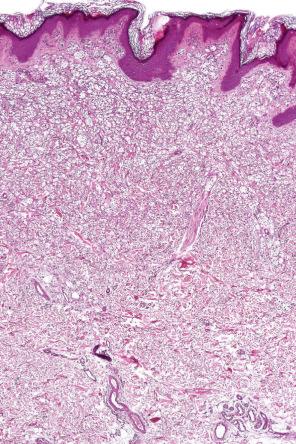
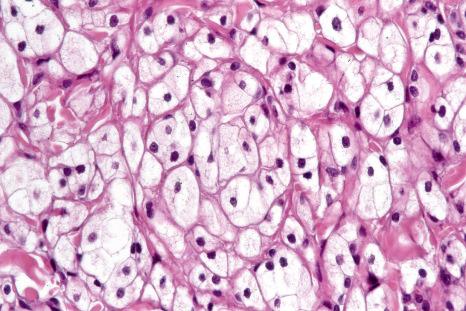
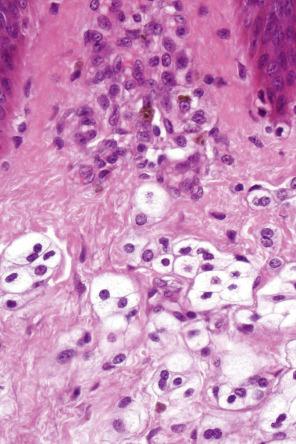
Balloon cell change has also been reported in proliferative nodules developing in the background of a large congenital melanocytic nevus.
Balloon cell change has also been documented in Spitz nevi, dysplastic nevi, cellular blue nevi, combined nevi, and melanoma (including metastatic tumors). The last may be distinguished by the presence of nuclear pleomorphism, nucleolar prominence, and mitotic activity.
It should be noted that balloon cell melanoma can, on occasion, appear deceptively bland (similar to nevoid melanoma) and, as a result, balloon cell nevi should always be carefully scrutinized at multiple levels to exclude a melanoma.
Halo nevus (Sutton nevus, leukoderma acquisitum centrifugum) presents clinically as a pigmented melanocytic nevus surrounded by a hypopigmented border and is usually associated with regression. Rarely, development of a halo phenomenon in a melanocytic nevus can be predated, especially in children, by a preceding elevated or verrucous and crusted surface. Occasionally, a halo may be seen around a congenital melanocytic nevus, blue nevus, Spitz nevus, dysplastic nevus, or even melanoma.
Typically, halo nevus presents as a small pigmented macule surrounded by a narrow border of hypopigmentation ( Figs 25.98–25.100 ). The incidence is equal in men and women. It arises most frequently in the second decade, usually on the trunk, particularly the back. The developing of a melanocytic lesion with a halo in an old adult should be viewed with suspicion. Halo nevi are sometimes multiple and occasionally exhibit a familial tendency; there is an increased incidence of associated intralesional and extralesional vitiligo. Halo nevi are up to 10 times more frequent in patients with vitiligo than in the general population. In addition, children with halo nevi and vitiligo are more likely to develop generalized than segmental or focal vitiligo. Development of multiple halo nevi has also been reported following treatment with infliximab, imatinib, and interferon beta-1a. Furthermore, a short period of sunbathing has also been associated with the development of multiple halo nevi. Patients with halo nevi very often have circulating antibodies to cytoplasmic antigen(s) in melanoma cells. These antibodies disappear after excision or spontaneous resolution of the central lesion. Patients with Turner syndrome have an increased prevalence of halo nevi compared with the general population (18% vs. 1%). An association of multiple halo nevi with carcinoid tumor of the ileum has been described. Mycosis fungoides superimposed on a melanocytic nevus can present clinically with a halo phenomenon.
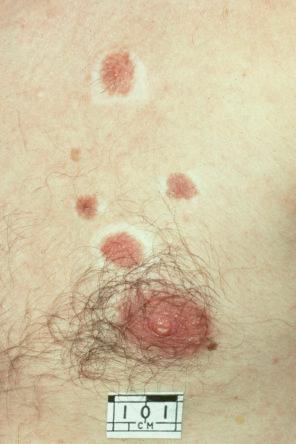
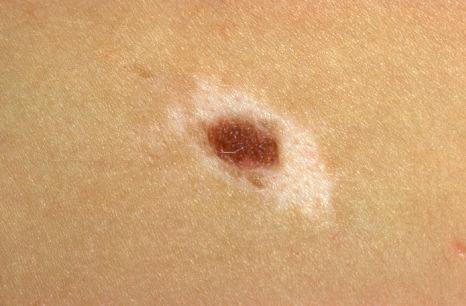
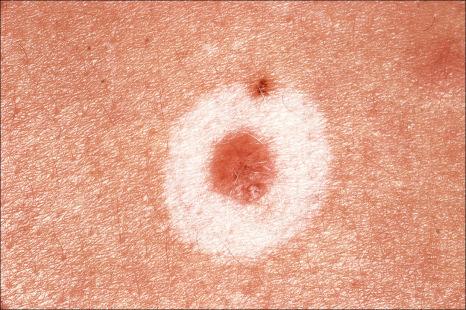
The natural history of halo nevi is usually associated with persistence for years, often even more than a decade, frequently without complete regression.
The lesion consists of a raised dermal nodule associated with an acanthotic and frequently hyperkeratotic epidermis ( Fig. 25.101 ). The nevus is usually compound and infiltrated extensively by lymphocytes and histiocytes with occasional mast and plasma cells ( Figs 25.102 and 25.103 ). The lymphocytes are predominantly of suppressor/cytotoxic T-cell phenotype, admixed with a minor population of CD4-positive T-helper cells, B lymphocytes, macrophages, and Langerhans cells. Epithelioid granulomata can occasionally be found within the inflammatory cell infiltrate. With progressive apoptosis, the nevus cells may become increasingly more difficult to identify, and their numbers are replaced by pigment-containing macrophages. Degenerative cytological atypia may be seen. Mitotic activity is not a feature. However, inflammatory cells are often mitotic, and this is often a challenge. An accurate evaluation of the proliferation rate in the melanocytes population is aided by immunohistochemistry for Ki-67 counterstained with a melanocytes marker such as Melan-A using two different colors. Maturation is very difficult to evaluate during the evolution of the lesion, particularly in late stages due to the prominent inflammation. Residual nevus cells may be highlighted with immunohistochemistry using a melanocytic marker like S100 protein ( Fig. 25.104 ). Since the latter often stains variable numbers of reactive dendritic cells, a marker such as MART-1/Melan-A may be used, remembering that the latter may sometimes label macrophages. It is at the late stages that the lesion may be histologically mistaken for melanoma. In the center of the lesion, blood vessels may sometimes be conspicuous. Rarely, halo nevi may develop in the absence of an inflammatory cell infiltrate. Some lesions display identical histologic features to those seen in halo nevi, but a halo is not noticed clinically. Such lesions are described as showing a halo phenomenon.
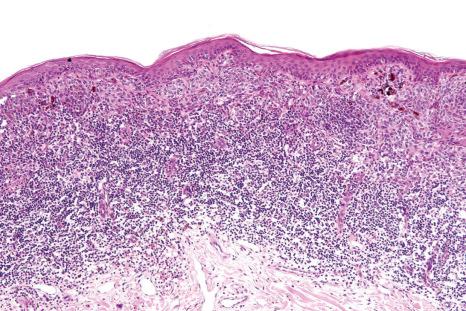
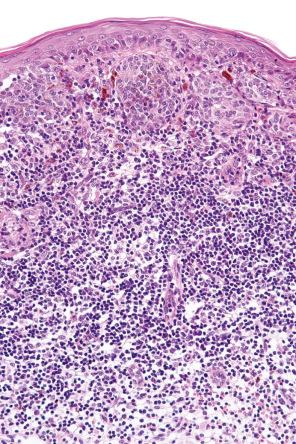
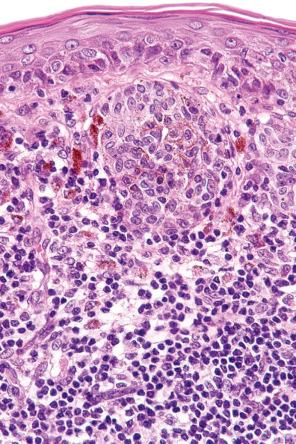
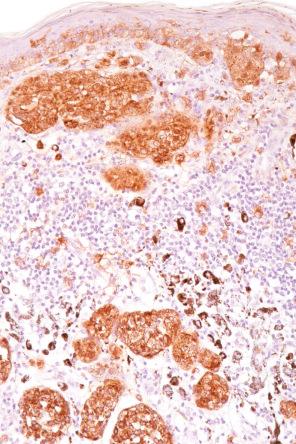
The depigmented halo shows a complete absence of melanin pigment accompanied by a negative dopa reaction. Often, complete absence of melanocytes is also seen. The epidermis, however, contains increased numbers of Langerhans cells.
The resolved nevus is characterized by epidermal hypopigmentation accompanied by scattered dermal melanophages. Mild scarring may sometimes be evident.
The halo nevus must be distinguished from melanoma. Typically, mitotic activity and nuclear and cytoplasmic pleomorphism (except the degenerative changes mentioned before) are not features, except in those that represent regressing melanoma or dysplastic nevi. Evaluation of mitotic activity in the melanocytes of halo nevi is often difficult because inflammatory cells are mitotically active. Double staining with Ki-67 and a melanocytic marker such as Melan-A is useful in identifying the proliferating population of cells. Also, the cellular infiltrate accompanying melanoma is usually more monomorphic and often hugs the base of the tumor rather than actively infiltrating it, except in those undergoing regression.
Become a Clinical Tree membership for Full access and enjoy Unlimited articles
If you are a member. Log in here